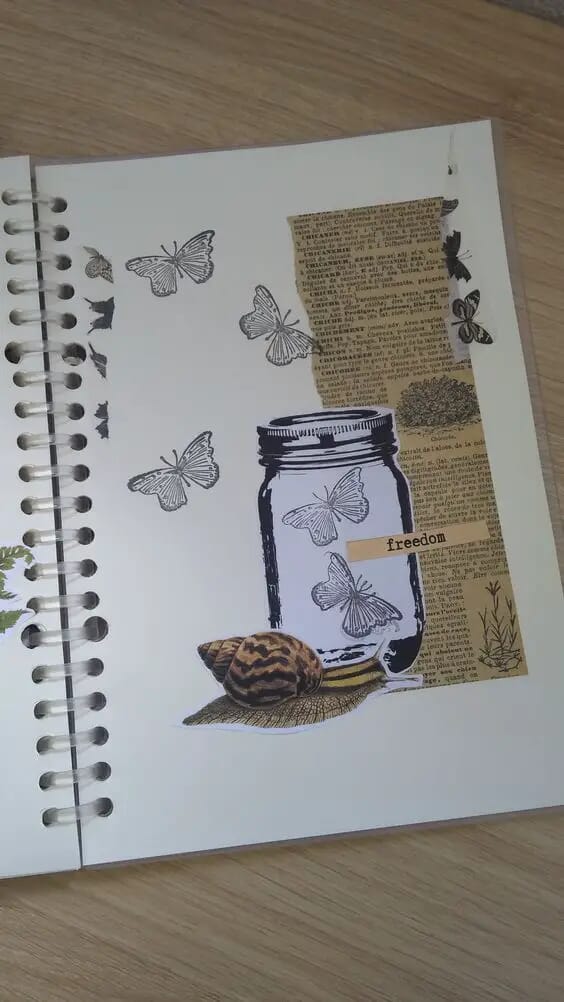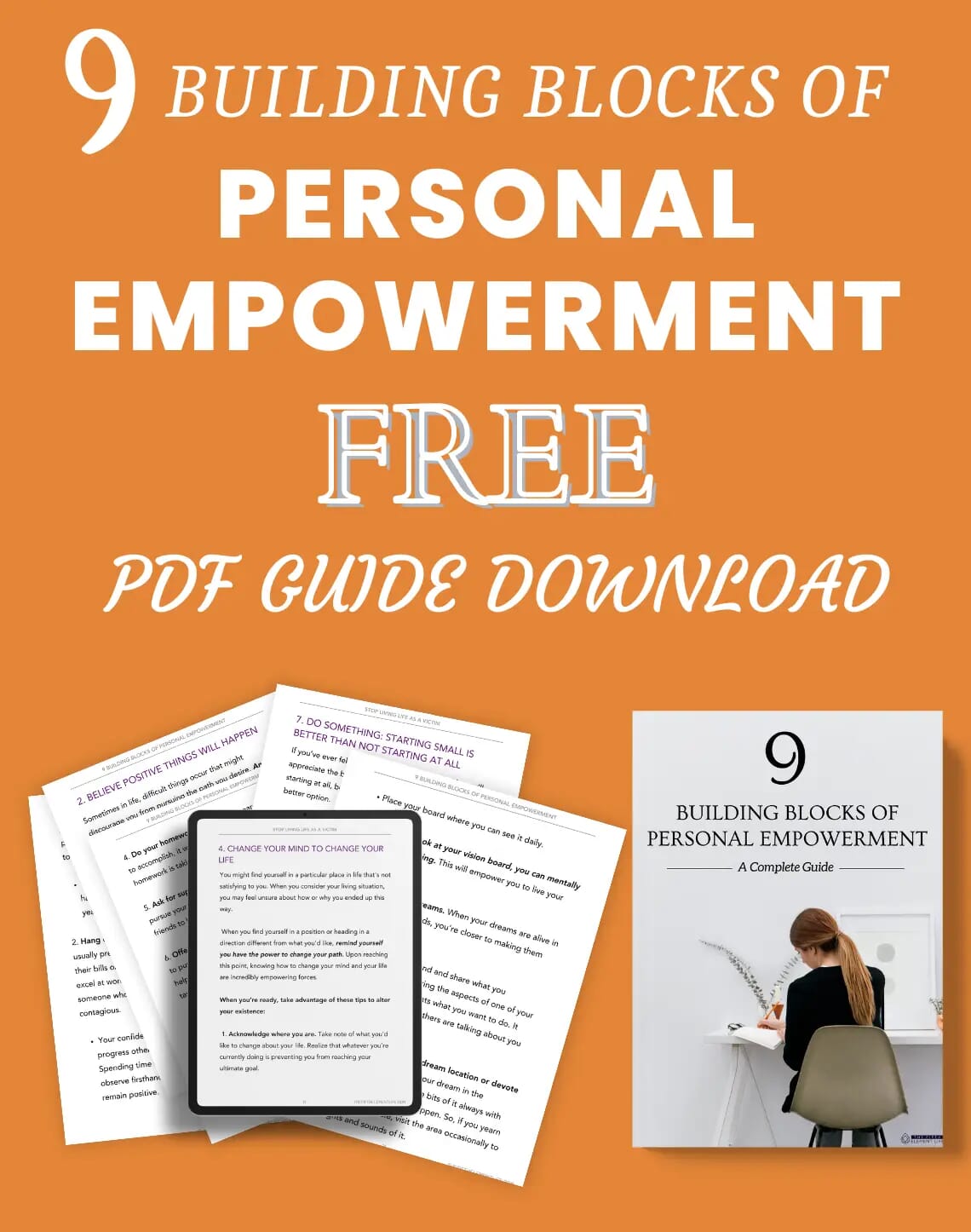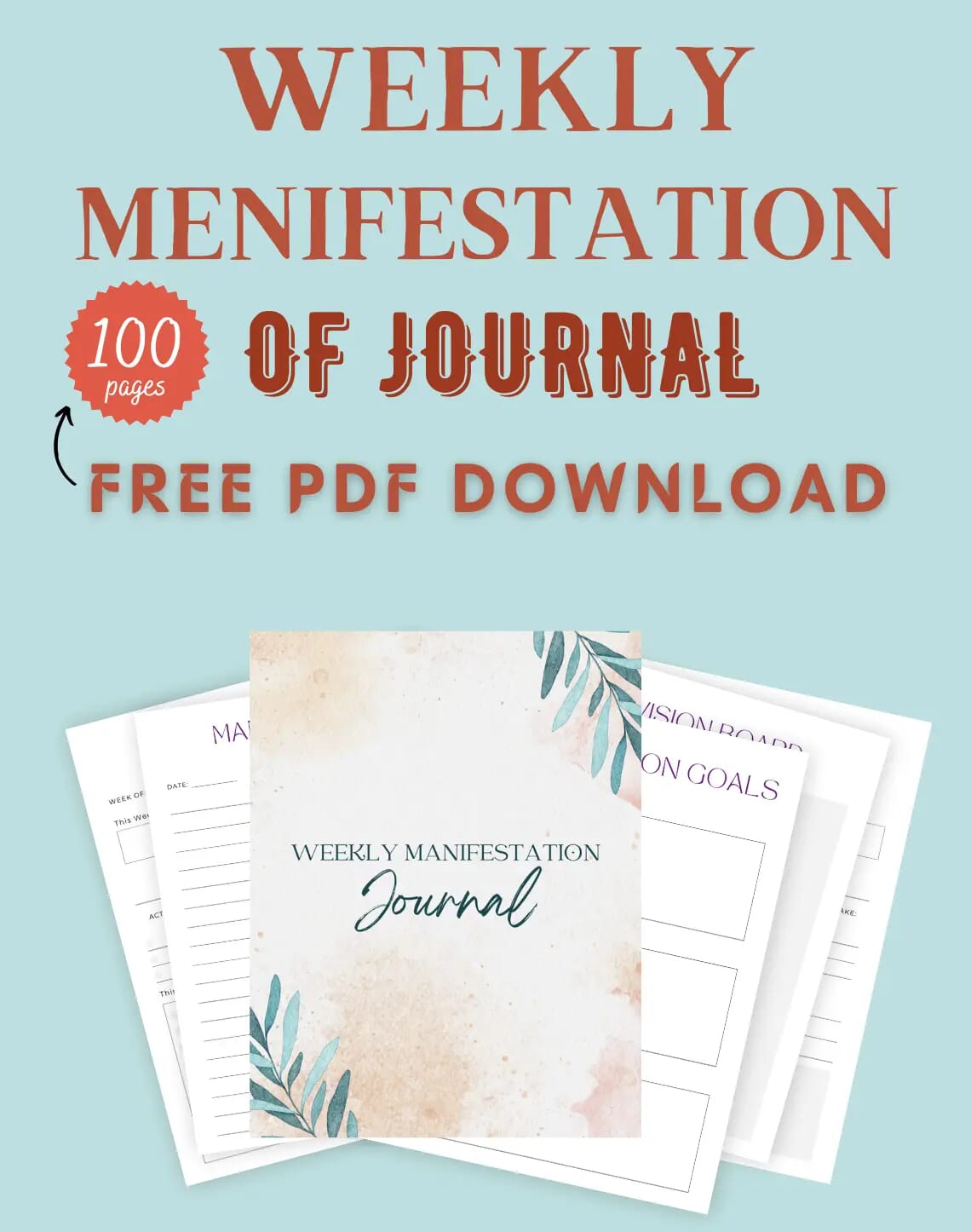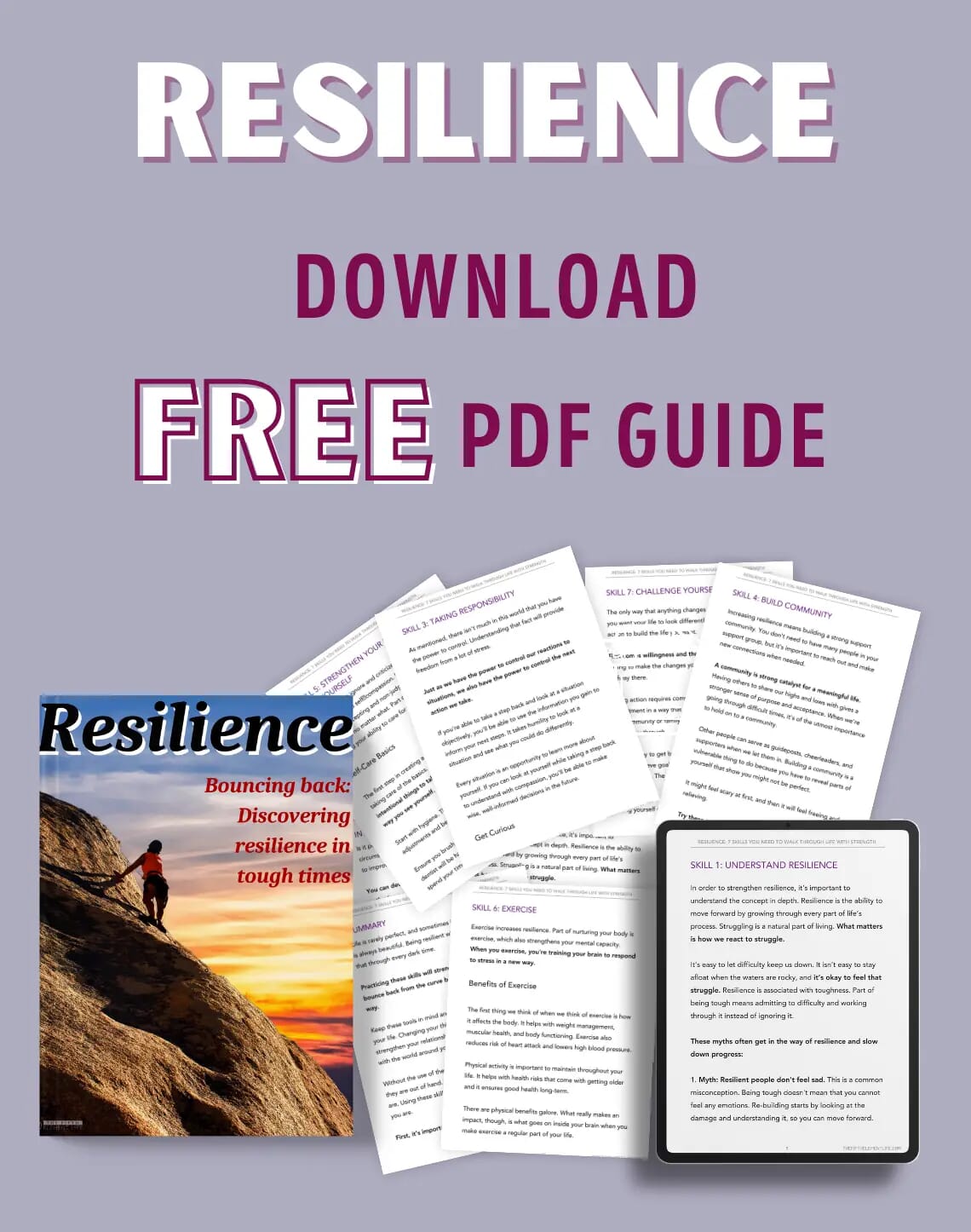Last Updated on May 25, 2023
When we think about visual journal, we typically imagine a notebook with an array of words that convey our thoughts, feelings and experiences.
For me, journaling has always been a great way to not only self reflect but also to grow.
But what if you’re a person who wishes to start their self-discovery journey but aren’t terribly word-savvy?
Well first things first, journaling should never be a literary contest- it doesn’t matter how you write something, what matters is what you are writing and that it is a reflection of your inner world.
Now, maybe you’re still thinking, “words just aren’t my thing”.
If this is you, you’re going to want to read on because this article is all about visual journaling.
That’s right, for this technique, we are calling all of our fellow scrapbookers, painters, photographers and art enthusiasts.
And don’t worry, you don’t have to be Picasso to get the most out of this method of journaling.
The most important thing is that you look within, harness the transformative powers of self-expression through visual aids, and have fun!
What is a visual journal?
So what is a visual journal exactly?
Essentially, it is what the name implies- a notebook that allows you to express yourself not only with words but also visual components such as drawings, paintings, collages, photographs, and other types of media.
If you love a creative project or are simply wanting to try something new in your spiritual journey, visual journaling is a great idea.
I found visual journaling at a time of my life when I was feeling lost.
I had experienced several hardships and was losing sight of who I was.
I decided to take a solo trip around Europe and do some soul searching.
One day, I was at the beach in Mykonos and was collecting small seashells when I got the idea- how fantastic would it be to incorporate my physical world into my inner world?
I had been journaling on a day to day basis anyway (if you’ve never tried it, I highly recommend travel journaling), so I was already in possession of some of my basic supplies.
Over the next few days, I began collecting a variety of other materials such as polaroids I had taken on my trip, flowers and little souvenirs that made me feel inspired.
As I incorporated these into my daily journaling practice, they reminded me of not only the special moments I had experienced abroad, but also how much beauty there is in this world.
I began seeing things differently not only in my external environment but also my internal one.
And this is exactly the point I want you to take away with you, if done with passion and motivation, visual journaling has the power to both heal and inspire.
It’s a way to spark creativity in a private space absent of any judgment, while allowing yourself to evolve emotionally and spiritually.
So what are you waiting for?
RELATED: 103 Phenomenal “Focus On What You Can Control” Quotes To Live A Rich And Rewarding Life
Types of visual journals
Visual journals can take on the form of many different styles. My journal, for example, was what is known as a travel journal.
Depending on the person’s needs and desires, every visual journal will look a little different for everybody.
To gain a better understanding of the various types, make sure to check out the following list:
- Art Journal: In this type of journal, as you may have guessed, art is the central focus. This method is perfect for people who wish to engage in a fun and therapeutic creative project, as it includes everything from drawings to paintings to collages. Get the most out of it by jotting down feelings that arise as you’re journaling.
- Travel Journal: Do you identify as a fellow globetrotter? Then this might be the method for you! In this type of journal, you can document your trip while maintaining an awareness of your thoughts and feelings abroad. You can use anything from seashells to museum entrance tickets to polaroids as inspiration.
- Gratitude Journal: Whether you just recently celebrated Thanksgiving or are feeling particularly grateful as of late, a gratitude journal will make you more appreciative of the people, things and experiences in your life. Some ideas to get you started include drawing a loved one or attaching some of your favorite gratitude quotes.
- Dream Journal: Have you always been fascinated by dreams and your subconscious? I know I have! A dream journal allows you to write down your dreams and provides the opportunity to interpret them. For a visual component, try drawing a scene from your dream that resonated with you.
- Bullet Journal: If you’re a person who always writes a list before heading to the grocery store, a bullet journal may be just what you need. This method consists of lists, charts, and calendars to help you stay organized and focused.
- Personal Journal: There are many ways to express yourself. This can manifest itself through clothes, hobbies and you guessed it, visual journaling. Explore who you are by creating a canvas that represents your internal world.
This list is, of course, just a small presentation of the vast array of types of visual journals. But now that you get the gist of it, regardless of your intentions, you can adapt your journal to your own personal interests, goals and needs.
Benefits
Although visual journaling can seem like it’s all arts and crafts, taking the time to explore yourself regardless of the method is hugely beneficial.
In my experience, for example, when I started visual journaling I noticed that I became significantly more aware of not only myself, but also my surroundings.
Not only this, but it also acted as a great stress relief when I started feeling anxious.
The benefits of visual journaling are endless. Here are a few:
- Promotes Self-Awareness: When I started actively journaling, I became significantly more aware of my thoughts and feelings. This in turn allowed me to identify the areas that I needed to work on and come up with ways to make the necessary positive changes in my life.
- Reduces Stress: As a person with a proclivity toward being anxious, stress and its effects are like second nature to me. Looking back, I can definitely say that a significant contributor to my stress was feeling discontent with my life. I had moved to Europe but wasn’t moving forward career wise. Once I began focusing on the positives in my life, like realizing that having the opportunity to live abroad at all was incredible itself, my mindset changed. My anxiety began to diminish and I was able to manage future challenges with greater ease. Plus, with visual journaling, I got to do this in a creative and engaging manner that made the whole process fun (creative activities specifically are also known to reduce stress).
- Boosts Sreativity: Despite having acquired many wonderful qualities from my mom, one of the not so great genetic attributes I received was her artistic abilities- yes, I still draw people as sticks. And, while my human drawing skills may never improve very much, I have been able to develop a variety of other creative abilities via visual journaling. If you also want to get your creative juices flowing, I highly recommend this method.
- Helps With Problem-Solving: We all face challenges in life and when this happens, finding the right solution can be tricky. Sometimes, the best steps to take aren’t clear and you’re left feeling stressed and discouraged. Visual journaling allows you to become aware of the particular obstacle and figure out the different ways you can address and overcome it. It’s a powerful tool that has aided me in many conflicts in my life, such as how to resolve a conflict with a friend or overcome a setback at work.
- Provides A Record Of Your Growth: when you’re feeling stuck or discouraged, looking at previous entries and seeing how far you’ve come can give you not only a new sense of hope, but also motivate you to keep working towards your dreams.
- Enhances Mindfulness: As a spiritual individual, it’s extremely important to me that I live my life presently and with awareness. When I started daily log journaling, it allowed me to be more mindful of how I was spending my time and upon reflection, establish what activities I valued and what activities weren’t serving me.
Supplies To Get Started
Before engaging in visual journaling, you may want to collect a few supplies to enhance your overall experience.
I, for one, highly recommend colorful paper, stickers and all the glitter you can get (however my girly nature may be slightly biased).
And remember, visual journaling doesn’t have to be expensive.
A journal and a few pencil crayons are perfectly sufficient to get you started.
- Journal: The first thing you’ll need is a journal to use as your visual journal. You can choose any type of journal that you like, but it’s important to choose one that can handle both written and visual elements. A blank sketchbook, mixed media journal, or watercolor paper journal can all be good options.
- Writing tools: You’ll need some pens or pencils to write in your journal. You can choose any type of writing tool that you like, but it’s a good idea to have a few different options, such as a black pen, colored pencils, and markers.
- Art supplies: Depending on the type of visual journaling you want to do, you may want to have some art supplies on hand. These could include paints, watercolors, pastels, colored pencils, markers, or other art materials that you enjoy working with.
- Glue or adhesive: If you plan to include collage elements in your journal, you’ll need some type of adhesive to attach them. A glue stick, double-sided tape, or a glue pen can all work well.
- Scissors: You’ll need a pair of scissors to cut out images or other materials for your journal.
- Optional supplies: There are many other supplies you can use to enhance your visual journal, depending on your personal preferences. Some optional supplies include washi tape, stickers, rubber stamps, stencils, and ephemera like ticket stubs, postcards, or magazine clippings.
Step-By-Step Instructions
Now that we’ve got all the prep work out of the way, it’s time to see how exactly you can create a visual journal.
Here are step-by step instructions:
Step One: Choose Your Journal
The first step to starting a visual journal is to choose the perfect journal to suit your needs.
Your journal will be your companion on this journey of self-discovery, so it’s important to choose one that feels comfortable and inspiring to you.
For me, as a kid, this came in the form of a hot pink cover decorated in lipsticks, heels and short sayings like, “omg” (I was very extra as a child).
As an adult, I now tend to opt for more tranquil colors such as pastels, and images that make me feel at peace, such as the ocean or flowers.
There are many different types of journals available, from blank sketchbooks to mixed media journals, watercolor journals, and more.
You can choose one that already has lined or blank pages, or you can select a journal that is specifically designed for visual journaling with thicker paper that can handle mixed media.
When choosing your journal, consider the size and format that will work best for you. Do you prefer a larger journal that provides ample space for writing and drawing, or a smaller one that’s more portable and easy to carry around? Would you like a hardcover or a softcover journal?
Once you have chosen your journal, take a moment to personalize it and make it your own.
You can decorate the cover with your favorite stickers, washi tape, or other embellishments, or write your name or a meaningful quote on the front.
This will help you to feel more connected to your journal and motivate you to use it regularly.
Keep in mind that your journal is a reflection of you and your unique creative voice, so choose a journal that feels right for you and enjoy the process of making it your own.
By taking the time to choose the perfect journal, you’re setting yourself up for success and giving yourself the space to explore your thoughts feelings, and creativity in a meaningful way.
Step 2: Set Your Intention
Before you begin writing in your visual journal, it can be helpful to set an intention for your practice.
This can be a simple statement or affirmation that reflects your goals and aspirations for your visual journaling practice.
Setting an intention can help you to focus your energy and attention, and provide a framework for your journaling practice.
It can also help you to stay motivated and committed to the process, especially on days when you may not feel inspired or motivated to write.
To set your intention, take a few deep breaths and reflect on what you hope to gain from your visual journaling practice.
RELATED: Over 120 Joe Dispenza Quotes On Controlling The Mind To Make Positive Change
What are your goals and aspirations? What do you want to explore or express through your writing and art?
Once you have a sense of your intention, write it down in your journal. You can write it on the first page or create a special page dedicated to your intention.
Some of my personal intentions include, “I intend to trust the timing of my life” and “I want to live more presently”.
Remember, your intention is personal to you, so there is no right or wrong way to set it.
It could be as simple as a few words or a more complex statement, as long as it resonates with you and feels authentic to your goals and aspirations.
By setting your intention, you’re creating a foundation for your visual journaling practice that will guide you throughout your journey.
You’re also taking an important step towards cultivating greater self-awareness and creativity in your life.
Don’t forget to add some color and fun artistic elements to get the most out of this practice and make it a truly authentic visual journal!
Step 3: Create A Daily Practice
To get the most benefit from your visual journaling practice, it’s important to establish a daily practice- I know, that kind of commitment can be daunting.
But take it from me, it’s totally worth it!
And it doesn’t have to be a long or complex practice, but rather a simple habit that you can incorporate into your daily routine at a time that best fits your schedule.
Set aside a specific time each day to work in your visual journal, whether it’s in the morning before you start your day or in the evening.
My favorite time to write is right when I get up, so that I can start every day on a positive note. However, at night before bed is also great to ensure a peaceful sleep (as an insomniac, I sometimes like to do this).
This regular practice will help you to build momentum and consistency, and make it easier to stay motivated and committed to your journaling practice.
When you sit down to write in your journal, try to create a quiet and relaxing environment. This can be as simple as lighting a candle or playing some soft music in the background.
Take a deep breath (or several, if you’ve had a really rough day) and center yourself before beginning your journaling practice.
Remember that there is no right or wrong way to journal. You can write about anything that comes to mind, from your hopes and dreams to your fears and frustrations.
You can also use your journal to create art, such as drawing or painting, to express your emotions and creativity.
Try to approach your journaling practice with an open and curious mind, and allow yourself to be playful and experimental.
Don’t worry about creating something perfect or polished – the goal is simply to explore your thoughts and feelings in a safe and supportive space.
By establishing a daily practice, you’re creating a habit that will help you to build self-awareness, reduce stress, and enhance your creativity.
You’re also creating a ritual that can bring a sense of peace and grounding to your daily life.
Step 4: Use Prompts or Themes
If you’re feeling stuck or unsure about what to write or draw in your visual journal, using prompts or themes can be a helpful way to spark your creativity and inspiration.
Prompts can be simple questions or statements that prompt you to explore a specific topic or idea.
For example, you could write about a happy memory from your childhood, your favorite place in nature, or your current emotions about a specific situation.
Themes can be broader topics or ideas that you explore over a period of time. For example, you could choose a theme of gratitude and spend a week or month exploring different aspects of gratitude in your visual journal.
There are many resources available online with prompts and themes for visual journaling, or you can create your own based on your interests and goals.
Using prompts or themes can help you to stay focused and motivated in your journaling practice, and provide structure and direction for your writing and art.
They can also help you to explore different aspects of yourself and your life, and deepen your self-awareness and understanding.
Here are some examples of journal prompts to get you started:
Draw a self-portrait in your current emotional state.
Write about a childhood memory that still holds meaning for you.
Draw a picture of your favorite place in nature and write about why it’s special to you.
Create a page inspired by your favorite song or piece of music.
Write about a challenge you’re currently facing and explore different strategies for overcoming it.
Draw a picture of someone you admire and write about what you admire about them.
Create a page inspired by a quote that resonates with you.
Write about a fear or insecurity that’s holding you back and explore ways to overcome it.
Draw a picture of a place you’d like to visit and write about why it’s important to you.
Write about a dream you’ve had recently and explore its possible meanings and significance.
These are just a few examples of visual journal prompts, and there are countless others out there.
The key is to choose prompts that resonate with you and reflect your interests and goals.
Use Crystals
To enhance your journaling experience even further, you can use other spiritual methods. One of these is the use of crystals.
Like some of you might be feeling right now, I was also highly skeptical of this practice at first. But as I explored my spiritual journey further and experienced first hand the transformative powers crystals had on my manifestations, there was no turning back.
Now everytime I journal, I always have my amethyst and rose quartz by my side (these have great soothing properties and aid in controlling my anxiety).
There are many ways you can incorporate crystals or crystal jewelry into your visual journaling practice.
Here are a few ideas:
- Choose a Crystal to Work With: Start by choosing a crystal that resonates with you and your intention for your visual journaling practice. You might choose a crystal based on its properties, such as enhancing creativity or promoting focus, or simply based on its beauty and appeal.
- Hold the Crystal While Journaling: Hold the crystal in your hand while you journal, focusing on its energy and intention. You might even close your eyes and take a few deep breaths, allowing yourself to connect with the crystal’s energy before beginning your journaling practice.
- Create a Crystal Grid: Set up a small crystal grid on your journaling surface, using crystals that correspond with your intention or theme for the day. Arrange the crystals in a pattern that feels visually appealing to you, and allow yourself to connect with their energy as you begin to write or draw.
- Wear Crystal Jewelry: Wear crystal jewelry, such as a necklace or bracelet, as a reminder of your intention to engage in your visual journaling practice. You might even choose a piece of jewelry that corresponds with the theme or prompt you’ve chosen for the day.
- Meditate with Crystals Before Journaling: Spend a few minutes meditating with your crystals before you begin your visual journaling practice. Close your eyes and visualize yourself connecting with the crystal’s energy, allowing it to guide and inspire your journaling.
Play Music
Playing music while journaling can also be very beneficial!
Music has the power to influence our mood and emotions, and can help to create a conducive atmosphere for journaling.
Classical music has been proven to aid in concentration, but if you’re in the mood for something a little more upbeat, you can never go wrong with a little ABBA (Mama Mia may or may not be one of my favorite musicals).
Here are some ways that playing music can be helpful during your visual journaling practice:
- Creating a Relaxing Environment: Soft, soothing music can help to create a calming and relaxing environment, which can make it easier to focus on your journaling and connect with your inner self.
- Enhancing Creativity: Certain types of music can be especially helpful in enhancing creativity and inspiration. For example, classical music or instrumental music can help to stimulate the brain and promote creative thinking.
- Improving Mood: Listening to music that you enjoy can help to improve your mood and reduce stress levels. This can be especially helpful if you are feeling blocked or stuck in your journaling practice.
- Setting a Rhythm: Choosing music with a particular rhythm or beat can help to set a pace for your journaling, providing structure and flow to your writing or drawing.
When choosing music to play during your visual journaling practice, it’s important to consider the type of music that resonates with you and your intention for your journaling practice (for me it’s ABBA, but for you it may be heavy metal- we don’t judge here).
Experiment with different genres and styles of music to see what works best for you.
Ultimately, the goal is to choose music that helps you to connect with your inner self, promotes creativity and inspiration, and enhances your overall journaling experience!
Step 5: Reflect On Your Experience And Insights
For the last part of this guide, I want to talk about reflection.
Reflecting on your experience and insights is just as important of a part of the visual journaling process as is the writing.
Reflecting allows you to deepen your understanding of yourself and your thoughts and emotions, and can help you to identify patterns or themes that have taken place in your journaling practice.
To begin the reflection process, take a few moments to read back over what you have written or drawn in your visual journal.
As you do so, pay attention to any thoughts or feelings that come up for you. You might ask yourself questions such as:
- What emotions did I experience during my journaling practice?
- Did any new insights or realizations come up for me?
- What patterns or themes do I notice in my journaling practice?
- How do I feel now that I have completed my journal entry?
As you reflect on your experience, try to approach it with curiosity and openness, without judgment or self-criticism.
Remember, the goal of visual journaling is not to create a perfect work of art or to have all the answers, but to explore and express your inner world.
You might find it helpful to write down your reflections in your journal, or to simply sit quietly and reflect without any particular structure.
There is no right or wrong way to reflect on your experience; the most important thing is to allow yourself the time and space to do so.
By taking the time to reflect on your experience and insights, you can gain a deeper understanding of yourself and your emotions, and can use this awareness to support your personal growth and well-being.
RELATED: Over 100 Quotes Of Empowerment And Peace By Joseph Murphy
Next Steps:
If you’re wondering what further steps you can implement to enhance the journaling process even more, here are a few ideas:
- Continue to practice visual journaling regularly, whether it’s daily, weekly, or as often as feels right for you. The more you engage in this practice, the more you will develop your skills and deepen your understanding of yourself.
- Experiment with different materials and techniques to keep your practice fresh and engaging. Try using different colors, textures, and mediums to create a variety of effects in your visual journal.
- Consider incorporating other creative practices into your routine, such as mandala coloring books. Coloring mandalas can be a meditative and relaxing activity that can enhance your overall journaling experience. You can find a variety of mandala coloring books online or at your local bookstore.
- Don’t be afraid to seek support or guidance if you feel stuck or overwhelmed. Talking to a therapist or counselor can be a helpful way to process emotions and gain insights into your personal growth.
Ultimately, the most important aspect of visual journaling is to connect with yourself and express your inner world in a safe and supportive space, have fun and enjoy the process!
Frequently Asked Questions
What is the purpose of a visual journal?
The purpose of a visual journal is to combine visual and written elements to provide a creative, expressive, and personal space for self-reflection, artistic exploration, emotional processing, and documentation of experiences. It offers a versatile and visually engaging medium for individuals to engage with their inner world and create a unique record of their lives.
What are the benefits of art journaling?
Art journaling offers numerous benefits that can positively impact one’s emotional, mental, and creative well-being. Overall, art journaling offers a unique and versatile platform for self-expression, self-discovery, and personal growth, while also providing a creative and therapeutic outlet for individuals of all skill levels.
Why journaling is important for success?
Journaling is important for success because it serves as a powerful tool for self-reflection, personal growth, and goal achievement. By regularly writing down thoughts, ideas, and experiences, journaling helps to clarify thoughts, identify patterns, and gain insights into one’s emotions and behaviors.
Continue Reading 👉: 210 Inspiring Quotes To Motivate Men
- 49 Unique Self-Care Kit Ideas For Your Well-Being - February 14, 2024
- 85 Exciting And Encouraging Quotes About Trying New Things In Life To Inspire That First Step - February 14, 2024
- 125 Inspiring You Are Amazing Quotes For Yourself And The Special People In Your Life - February 14, 2024










